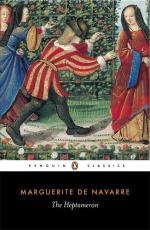2 Le Recueil de l’Antique
pre-excellence de Gaule, &c., by
G. Le Roville, Paris,
1551 (fol. 74).
3 Hilarion de Coste’s
Vies et Eloges des Dames illustres,
&c., vol. ii. p.
272.
Some idea of their appearance may be gained from a couple of the miniatures adorning a curious manuscript catechism composed for Margaret and now in the Arsenal Library at Paris.(1)
1 Manuscrits theologiques francais, No. 60, Initiatoire Instruction en la Religion chretienne, &c. In one of these miniatures the Saviour is represented carrying the cross, followed by Henry of Navarre, his brother Charles d’Albret, Margaret, and other personages, all of whom bear crosses, whilst in the background are some pleasure-grounds with a castle, a little waterfall, and a lake. Another miniature in the same manuscript shows King Henry of Navarre with a flower in his hand, which he seems to be offering to the Queen, who stands in the background among a party of courtiers. The King wears a surtout of cloth of gold, edged with ermine, over a blue jerkin, and a red cap with a white feather. Margaret is also arrayed in cloth of gold, but with a black cap and wimple. She is standing in a garden enclosed by a railing, and adorned with a fountain in the form of a temple which rises among groves and arbours. Beyond a white crenellated wall is a castle which has been identified with that of Pau. On fol. 1 of the same MS. the artist has depicted Queen Margaret’s escutcheon, by which we find that she quartered the arms of France with those of Navarre, Aragon, Castile, Leon, Beam, Bigorre, Evreux, and Albret.
The Court which Margaret kept in turns at Alencon, Nerac, and Pau does not appear to have been so sumptuous and gay as some of her biographers assert. Brantome mentions that the Queen’s two tables were always served with frugality, and Sainte-Marthe states that “she talked at dinner and supper now of medicine, of food wholesome or unwholesome for the human body, and of objects of nature with Masters Schyron, Cormier, and Esterpin, her expert and learned doctors, who carefully watched her eat and drink, as is done with princes; now she would speak of history or of the precepts of philosophy with other very erudite personages, with whom her house was never unfurnished; at another time she would enter into conversation on her faith and the Christian religion with Monsieur Gerard, Bishop of Oloron. Altogether there was not a single moment that was not employed by her in honest, pleasant, and useful conversation.” (1)




